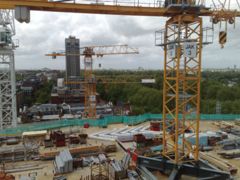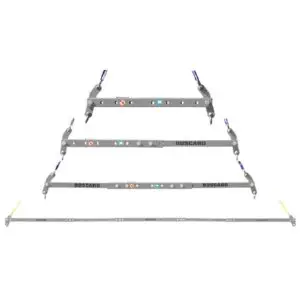England’s capital city remains a European hot spot of sophisticated tower crane application. Heinz-Gert Kessel reports from London
It is well known that the number of tower cranes on a major city’s skyline is used to give an at-glance indication of the status of the construction industry. A vantage point for the City of London is the upper gallery of St. Paul’s Cathedral from which to make a quick crane count. For a wider view over much of London go to Primrose Hill, on the north side of Regent’s Park, or Hampstead Heath. A recent count shows about 50-80 tower cranes while, during the boom years before 2008, never fewer than 150-180 cranes were visible.
It is clear evidence of the impact of the economic crisis. An example of the depth of this effect is HTC Plant which is typically prominent on the city skyline with a cluster of red Wolff luffers. At the deepest point of the economic crisis HTC had about half of its fleet in the depot. In 2009 there were nearly 40 proposals for skyscrapers which would have dramatically and rapidly changed the London skyline. HTC, as a supplier of specialized cranes for tall construction projects, would have particularly benefited from the forecast requirement for climbing tower cranes.
Planning for just around a quarter of those proposed building projects may be likely to go ahead. There are signs that some projects stopped in the wake of the banking crisis will be restarted. Due to space and airspace oversailing restrictions in London luffers dominate. Of the 210 cranes in the HTC fleet, the Wolff WK180 B is the most popular luffer.
Wolff tower projects in London include two 180 Bs for Bovis Lend Lease on the ‘L’ Block development of Imperial College London’s Hammersmith Campus. Occupation of the six-storey flagship building for Imperial’s Academic Health Science Centre is scheduled for 2012.
Due to the proximity of occupied buildings the cranes had to be positioned as close as possible to the new building’s foundation. Another requirement was a small tail radius. A cross frame base, secured with special Macalloy bolts, meant ballast could be reduced from 120 to 75 tonnes, helping the crane undercarriage to fit into the building under construction.
More 180 Bs are at work in London’s West End on a mixed use development of Park House by Mace for Land Securities on Oxford Street. It is the first new build on Europe’s busiest shopping street in 40 years. The first on the site was installed on a special expendable base foundation anchor that will become part of the new building. It is rigged in an unusual three line fall mode where, with just 7.1 m counterjib radius, capacity is 18 tonnes at 17 m.
HTC also supplied three more Wolff luffing towers for demolition contractor Keltbray. One with 35 m jib was climbing down 91.2 m alongside the building under demolition. Aware of the safety risk of the external climbing procedure, HTC developed a special climbing platform to give safe access for riggers attaching the collars and preventing objects from falling to the ground during installation of the tied-in supports. These platforms were developed to fit the 2 m and 2.5 m square Wolff masts, most commonly used for external climbing operation in London.
On nearby Regent Street another 180 B and a 100 B were supplied for the UK£160 million redevelopment of the Café Royal by Israeli hotel group Alrov. The 100 B lifts six tonnes at 23 metres and 2.6 tonnes at 40 m. The 180 B is configured for 12 tonnes capacity at 24 m and 6 tonnes at 40 m.
Engineering
In terms of numbers Terex Comedil luffing jib cranes, in most cases provided by Select Plant Hire, are dominant. Clusters of them are engaged at prestigious inner city projects, including the Shard, the Heron Tower, Cannon Street Station and Kings Cross Station. The luxury apartment towers of the Neo Bankside project next to the Tate Modern art gallery are served by high free standing topless Terex Comedils.
Custom designed engineering solutions by Select’s engineers are a common sight on installations under difficult site conditions. On the Cheapside building complex opposite St. Paul’s Cathedral the concrete core was finished with smaller free standing Terex Comedil luffers. Following this, a pair of CTL400s and two CTL340s were installed on top of these cores on a special steel grillage to raise the steel skeleton.
At Cannon Street station three 32 tonne capacity CTL630-32s were engaged in heavy steel erection work. Two had 50 m booms and one was rigged with 40 m boom. Like all Terex Comedil cranes above 300 tonne-metres capacity class, the CTL630-32 has a triangular actuating arm pushing a counterweight basket in and out to reduce the overturning moment. Its movement is according to whether the boom is lifted or lowered.
While this feature needs more rigging than fixed ballast luffers, it allows 70 m free standing 630 tonne-metre class cranes to be rigged on the economical to transport 2.32 x 2.32 m square HD23 tower system. In very short boom operating mode, however, the complete ballast in its swinging carrier increases the overturning moment. A better solution is a combination of fixed and movable ballast. The 40 m boom version, therefore, shows one 7,500 kg steel block fixed at the back of the machinery deck while the rest of the ballast is in the swinging counterweight.
The most eye-catching site served by Terex Comedil luffers is the 87 storey, 310 m Shard sky scraper. It will contain 17,000 tonnes of steel, 54,000 cubic metres of concrete and 56,000 square metres of glass on a footprint of one acre. When it opens in 2012 it is expected to be the tallest building in Western Europe. Seven months of construction time will be saved by building the tower and digging the basement at the same time. It is a new construction method that severely affects tower crane installation. Space restrictions for the number of hooks required meant luffers were the only reasonable choice.
Some of the three CTL180 and two CTL400s installed as external climbing versions for steel erection work are based on custom designed steel framework integrated in the foundation walls. It allows the crane mast to be standing cantilevered off its foundation. To save time steel construction started before the central concrete core. By the 10th storey the concrete core had caught up with and passed the steel erection. Steel erection cranes can now only work with a steep jib angle around the centre of the building under construction. The required capacity meant all cranes work in four line fall mode.
Standing tall
Across Europe there is an increasing number of skyscraper projects above 200 m. The 12 tonne single line capacity of the new Terex Comedil CTL340 displayed at the Bauma 2010 show could be a versatile improvement on the cases in London where 12 tonne loads still need two falls of rope.
In addition to the Shard, the recently topped out 230 m Heron Tower requires tall external climbing tower cranes. With one crane next to a busy road, Select mounted a special safety cage under the climbing frame to minimise the potential risk of objects falling during the climbing procedure. All cranes have an enclosed entrance into the tower base with a door that can only be opened by authorised people. An additional cage around the base tower section prevents climbing outside the tower.
Another site, at the busy Kings Cross Station, has two Terex Comedil CTL400s operated by Taylor Woodrow working with 60 m boom and 12 tonnes capacity in two fall mode. One is on a foundation pile with a special adapter section carrying the 30.38 m free standing crane. Underground train lines prevented installation on a conventional concrete foundation or undercarriage.
While the two big tower crane rental companies Select and HTC Plant are owned by contractors, Falcon Crane Hire is proud to operate the largest independent tower rental fleet. Being an independent player and not linked to a mother construction company allows other contractors an alternative to hiring from competitors. In the run up to the global financial crash in 2008 Falcon grew rapidly and benefited from a healthy house building boom. Since then, social housing and public sector contracts have been a primary source of business. Falcon’s fleet of more than 250 cranes includes a rising number from Spanish manufacturer Jaso.
Another independent tower crane rental specialist with a long history on London construction sites is Vertical Transportation Ltd. Tom Newell, managing director, is concerned about the benefit of being an independent company in the current economic climate. In his opinion the economic crisis hitting the house building industry made independent crane rental companies suffer more than those owned by a large construction company because those companies are bidding for other projects, for example, ones in the infrastructure, public construction and prestigious high rise sectors. On such projects it helps to be engaged in the early stage of crane planning by the contractor. This gives a further advantage to the rental companies owned by contractors.
The Vertical Transportation fleet includes special tower cranes, for example, the Krøll K103V double level luffing jib cranes and Tornborgs jack knife cranes popular for inner city site projects on cramped sites. Although the market for converting inner city office space into apartments dried up, there are still housing projects that need compact cranes which do not oversail neighbouring properties.
In response to a rising number of small- and medium-sized Jost hydraulic ram luffers in the city, Tom Newell points out a technical advantage of the Tornborg cranes. Compared with the Jost JTL68.4, the boom geometry on the luffing jib of a jack knife crane is unsurpassed in compactness and working speed, Newell says. It must be noted, however, that such a design feature is more expensive. With rental prices under pressure, Newell says it is impossible to run an updated jack knife crane, as represented by Artic crane, in competition with a Jost JTL68.4. It would only make sense in cases where the crane must be installed at the edge of a building leading to penetration of the neighbouring property’s air space or when creating an unacceptable minimum radius around the crane tower which can’t be served by the conventional design luffing jib crane.
City Lifting, however, which, at the time of writing already had two of the all-new Swedish built Raptor 84 Artic tower cranes, is confident that this city crane will become a common sight at London inner city sites. Only the principle of boom geometry can be compared to the Tornborgs veterans. While the UK is the core market, Stefan Olsson at Artic says the young company is looking at new markets around the globe as the new design offers benefits over competing small city luffing jib cranes.
Space needed when out of service is 4 m and, in working condition, the hook can be brought to only 2 m in front of the tower’s centre line. In addition, the crane is fast to rig and low weight. The complete boom weighs 5 tonnes and is transported as one folded unit with the hoisting rope already installed and connected with the hook block.
Typical rigging time, including the 1.2 x 1.2 m city tower, is 2.5 to 3 hours. Up to 20 m, 4 tonnes can be lifted while, at 32 m radius, capacity is 2 tonnes. This surpasses the load moment of the popular Magni S-46 Tornborgs jack knife crane where maximum load is restricted to 2 tonnes and, at the maximum outreach of 30 m, capacity is 1.25 tonnes.
Stefan Olsson still prefers the rope-operated luffing system over an hydraulic cylinder with power pack, due to a fear of oil leakage and the potential to spray a building site with hydraulic oil in the case of failure.
London Tower Cranes now runs a fleet of more than 300 cranes across the UK and northern Europe, following its alliance with Neremat N.V. in Belgium. LTC operates Jost JTL series luffers across the city. In designer Franc Jost’s opinion the fast rigging and economic crane design can also cope with difficult site conditions. Jost towers with the hydraulic luffing mechanism can be parked with slewing brakes engaged and an 85 degree boom angle in out of service condition. This unique application feature depends on the tower system in use and relies on the 25 and 30 m boom of the JTL68 and 30 to 35 m boom of the larger Jost JTL models.
In the 230 tonne-metre class Yongmao luffers have entered the London tower crane scene. Technical data shows them close to the Terex Comedil rival in the 260 tonne-metre class. As for the CTL 260-18 capacity is 18 tonnes. With 30 m jib the Yongmao STL230A can be rigged free standing on a 78.3 m tower using a 2.32 x 2.32 m mast section. While the mast sections look very similar to the common Comedil HD23 tower sections, they have jacking plates on two opposite sides. It means the climbing cage can be installed in two directions on the tower.
At the castle
Free standing height and a reduced number of bracings to the building were key features of the Liebherr 160 HC-L 8/16 Litronic used at the Castle House (known as Strata Tower) at Elephant and Castle. Contractor Brookfield gave several important factors in the choice of the Liebherr 160 tonne-metre luffer, including high lifting speeds for 6.5 tonne loads, installation on 500 HC tower sections for a 76.5 m free standing height with 40 m jib and only three tie supports for the 43 storey building.
Another prominent Brookfield development is the 288 m Pinnacle or Bishopsgate Tower, close to the Heron Tower. A new generation of four electric Favelle Favco luffers with up to 50 tonnes of capacity on 1.9 x 1.9 m tower sections were specially ordered for the project. For a full site report on these cranes, see IC September 2010, page 15.
Also starting in 2009 Liebherr delivered extraordinary hammerhead cranes for the elegant residential project One Hyde Park. Four interlinked apartment buildings step up in two-storey increments to give, from west to east, buildings of nine, 11, 13 and 11 storeys. Separating the blocks is a series of fully glazed cores, comprising passenger cores for occupants and service cores. The blocks were raised using Select Plant Comedil CTL400 luffers operated by main contractor and parent company Laing O’Rourke. The steelwork for the glazed cores was subcontracted to a Swiss steel erection company and was served by additional cranes.
The Comedil luffers occupied the space between the apartment blocks so the way to establish additional crane capacity was in the building’s roof. Two main restrictions had to be considered. First, the buildings had to take the extra load of the cranes. Second, air space was restricted by the existing luffers so cranes had to be selected that could work beneath them. The jibs had to be exactly long enough to cover the cores between the blocks.
Liebherr’s solution was in a customer-designed modification to the standard EC-B flat-top. Two 110EC-B6s were rigged with an extra short boom of just 12.5 m while a 30EC-B 2.5 was delivered with a extra short jib of 11.05 m. To cope with the static load of the buildings the roof mounted cranes were installed on purpose-built steel grillage under the standard cruciform base. As construction proceeded, one 110EC-B6 had to be relocated by the Comedil luffers from one apartment block to another. This relocation was quickly carried out due to quick assembly devices of boom and counter jib, plus the compact crane head that contained hoist gear and central switchgear. For safety reasons the flat top cranes working under the luffing jib umbrella cranes were equipped with yellow lights at the jib and counter jib end. In operation, the two-fall mode of the 110EC-B6 FR.tronic gave fast lifting cycles, while the high-performance drives allowed exact positioning of the delicate loads between the apartment buildings. The 110EC-B6 offers 6 tonnes over the complete working radius and the lightweight 30EC-B2.5 could lift 2.5 tonnes over the complete jib length.
Source:




